Artist Spotlight: Meera Chauda

Meera Chauda, The Emerald City 2, 2020
Tell us a bit about yourself and your practice, how would you describe the work that you do?
I am a visual artist based in London. I also work in the learning sector as an artist facilitator, consultant, researcher and mentor.
I find, make, and manipulate images in order to construct playful yet complex narratives. I re-create fictional female protagonists that belong to the childhood stories I have grown up with. These composite characters belong to many different stories and histories. Part Kali, part Alice in Wonderland, part me.
I use collage sometimes combined with drawing, photography, text and stitch. My process involves cutting, dissecting and reassembling. I play with images, organising them in a variety of ways, making combinations, moving elements, asking questions and then photographing the arrangements. Each piece is normally created from a sequence of photographed images.
The characters explore and inhabit spaces sometimes with heavily coloured/patterned backgrounds and foregrounds. Recent images disappear, are hidden, silenced and sometimes obscured. My images belong to many different histories. My images map and consider the confusion and complexities of home, heritage, legacy and place.
“The ordinary world turns upside down and backward; it becomes a world in which things go every way except the way they are supposed to” Martin Gardner, The Annotated Alice.
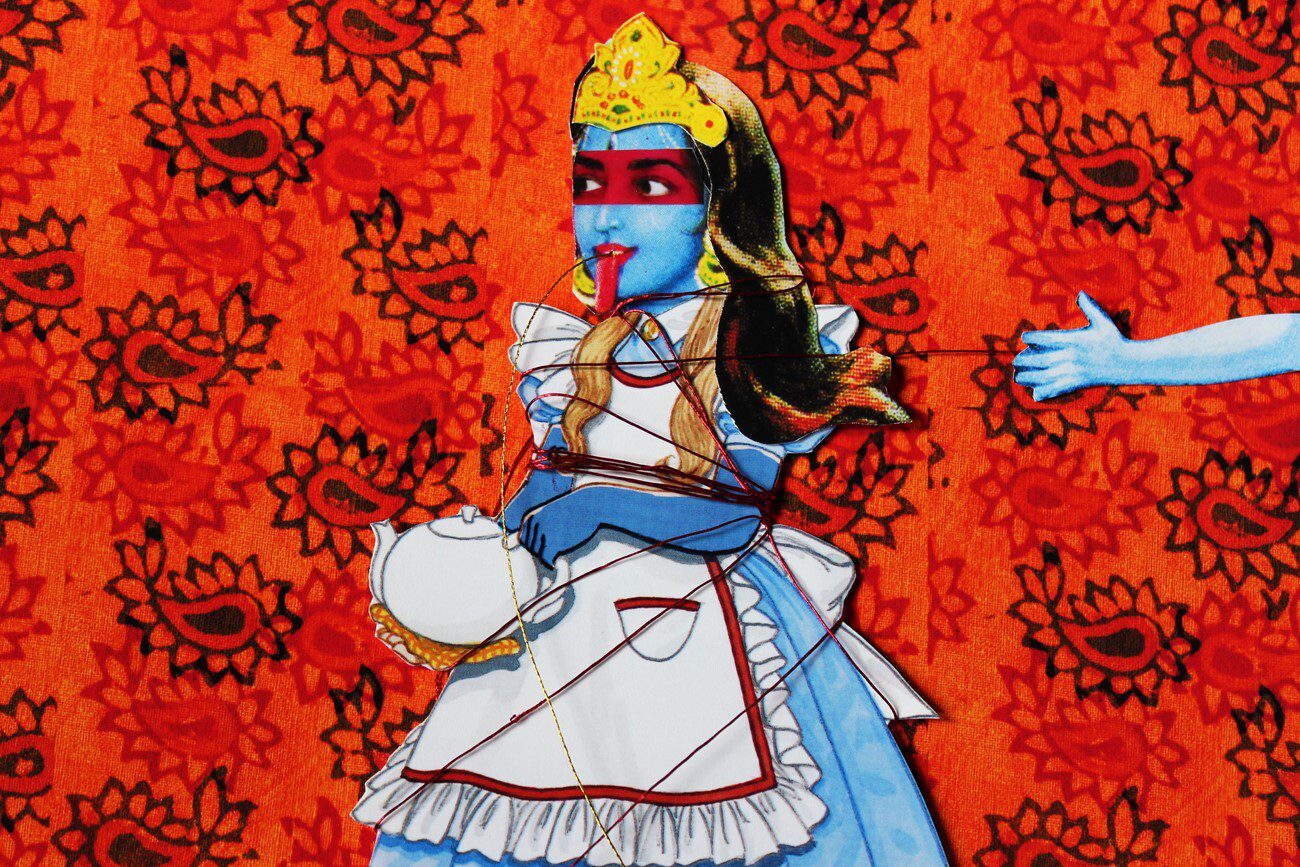
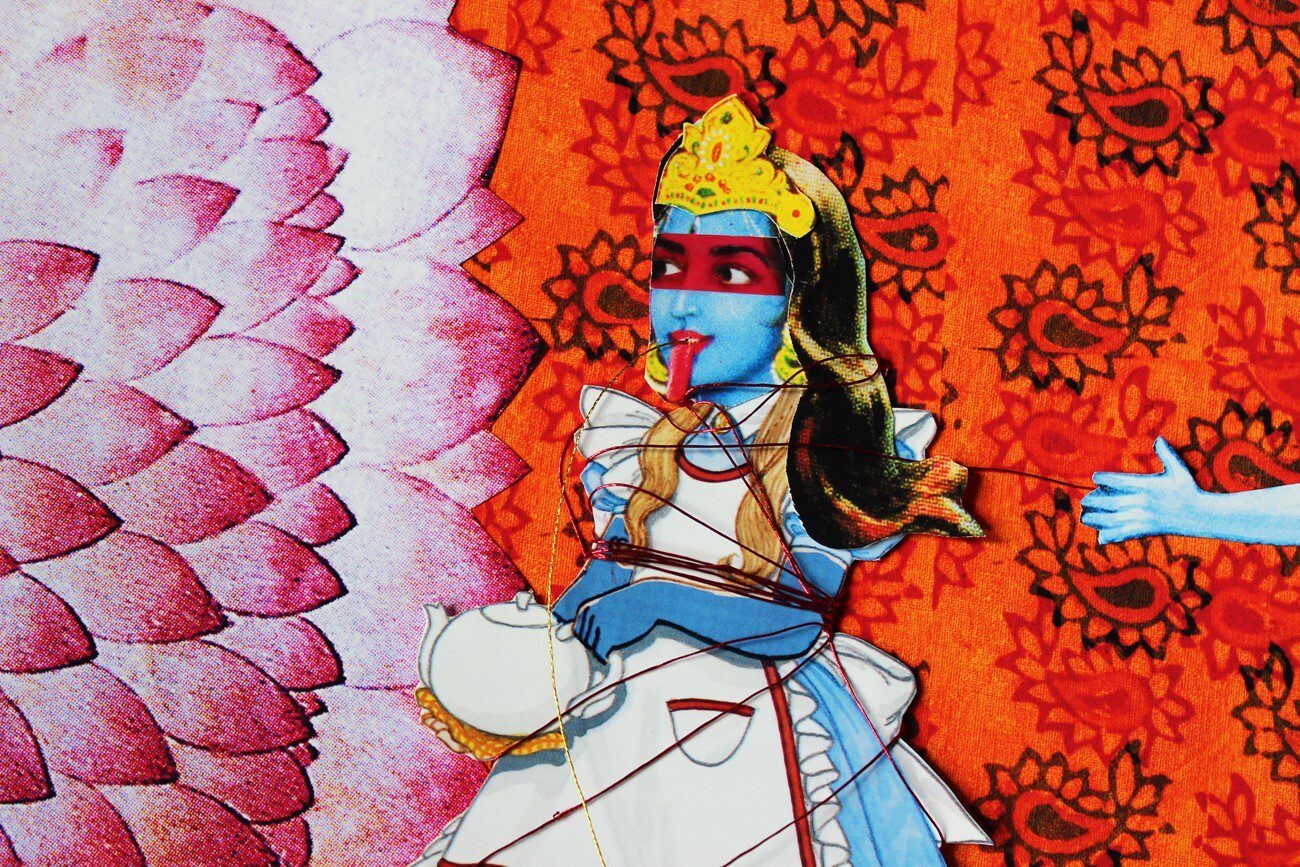
Collage and re-appropriation are used consistently within your practice. How do these processes speak to the themes within your work?
I enjoy the possibilities of collage – to reconstruct, re-make, shape, cut, combine and reassemble. I also like the physical act of cutting things out and re-constructing. I have recently started using photoshop which allows me to change the colour and size and play with layers, but I try and keep that to a minimum. In the end, all of my collages are handmade.
My process can be time-consuming; I make numerous images before settling on one or two that work. I sometimes feel as though they are all works in progress. I’m never sure when images are complete and finished. I’m not sure they ever are.
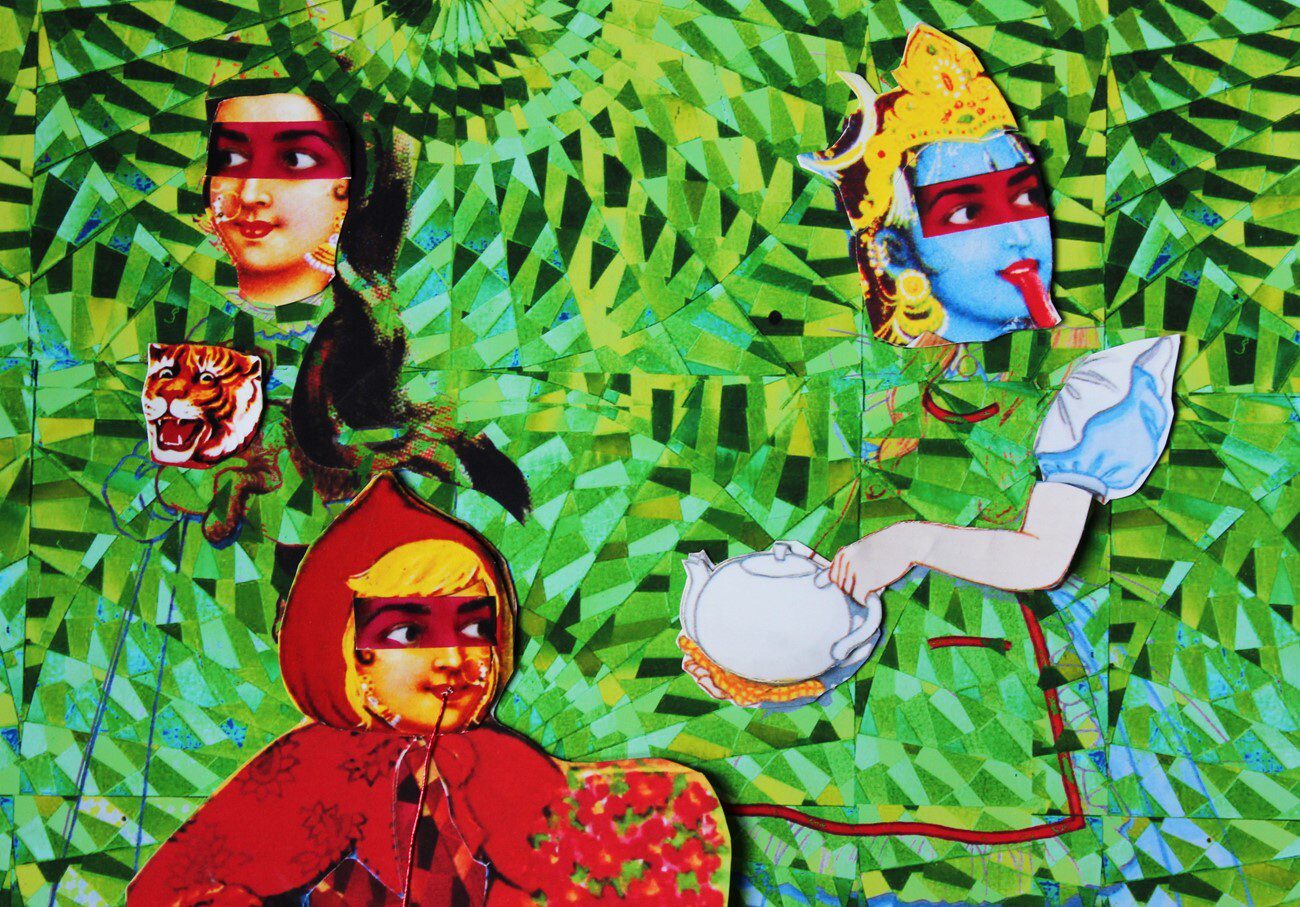
You draw from a mixture of different characters and a range of cultural references. I recognise Alice in Wonderland and the goddess Kali. Can you unpack some of these for us and talk a little about your choices?
I have a strong interest in fictional children’s stories, especially picture books where characters would embark on journeys exploring the notion of being away and home - entering an unknown and returning.
The images I use speak to me in some way. As a child I grew up with stories and images like Alice in Wonderland and The Wizard of Oz alongside Amar Chitra Katha comics and images of Hindu gods and goddesses. I’m interested in these juxtapositions.
My current focus is on female characters/icons exploring territory and finding a way through. Kali is a complex figure with many contrasting traits all of which are equally worthy expressions of female strength and energy, destructive and benevolent, powerful, a protector and destroyer. I think she looks so interesting too.
With Alice in Wonderland I’m interested in how she has to learn the rules of each new encounter while also trying to develop a sense of herself.
I also use Dorothy from The Wizard of Oz. I have spent the last few years researching the original story and books by Frank L Baum. The Wizard of Oz was the first book in a long series. I became interested in the film’s re-interpretation of the book, how aspects have been changed and re-imagined. The red shoes were originally sliver shoes. The Emerald City was only green because everyone had to wear green tinted glasses. I’m in the process of further research.
I’m interested in the layers of meaning and complexities in the retelling and reimagining of stories. The characters are both strange and familiar at the same time.

You also have a lot of experience leading creative workshops both inside and outside of the gallery and museum context. Does this type of collaboration and experience inform your practice?
My practice informs every aspect of my life.
I have spent the last 23 years working as an artist in the learning sector with schools, teachers, families, youth programmes and community groups. I have worked with numerous museums, galleries, schools and other cultural organisations to develop and facilitate projects, workshops, training, and evaluation.
I develop creative processes and activities that give people opportunities to create, think critically, share, debate, exchange, imagine and question. I am interested in setting up spaces where children, young people and adults can bring their lived experiences and tell their stories. I want them to leave with more questions than answers and for them to see and think differently after the experience. These intentions are echoed within my art practice.
Working with collections and exhibitions in the context of the learning sector has allowed me to develop a deep interest in research and processes of discovery. It has also allowed me to work across subject areas and explore the inter-connections and links between the arts, history, literacy, politics, maths, etc.
After years of working with art and historical collections and curriculums, my interest in the untold histories and post-colonial legacy has deepened, informed by the politics of space, diversity, class, privilege and under-representation. Both my art and educational practice explore my deep interest in how we articulate what is hidden, obscured and unspoken.
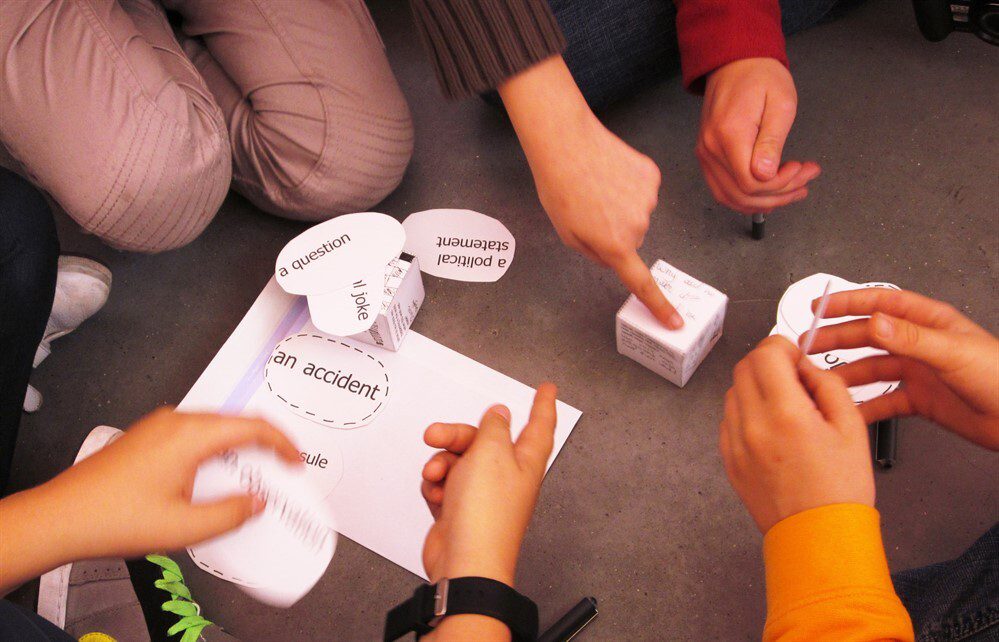
Can you tell us a little more about your background in this sector?
In the 90’s, straight out of college, I spent a few months volunteering for Shaheen Merali in East London to help organise The Panchayat Collection. This collection was co-founded by Shaheen Merali and Allan de Souza in 1988 after consultation with artists Bhajan Hunjan, Symrath Patti and Shanti Thomas.
The archive was self-funded and had a focus on Black and Asian artists and their work (1980’s-2003), as well as documenting their commitment to the intersection between race, class, gender, policed sexualities and (dis)ability. It was an inspiring archive for me to go through and started my interest in research, collections and archiving. It was encouraging to see South Asian Artists who had come before me and were reflecting some of my own experiences. The collection has now transferred to Tate Library.
My route into working in learning also began in the late 1990’s at The Whitechapel Art Gallery, in what was then called Community Education. It was through a specific call-out for Black and Asian artists and was my first opportunity to work with schools and teachers in London; it was also where I became interested in the possibilities of working with children, young people and teachers.
It’s interesting to see how decades on we are still asking the same questions and having the same conversations around the lack of representation, inclusion and visibility within the cultural sector.
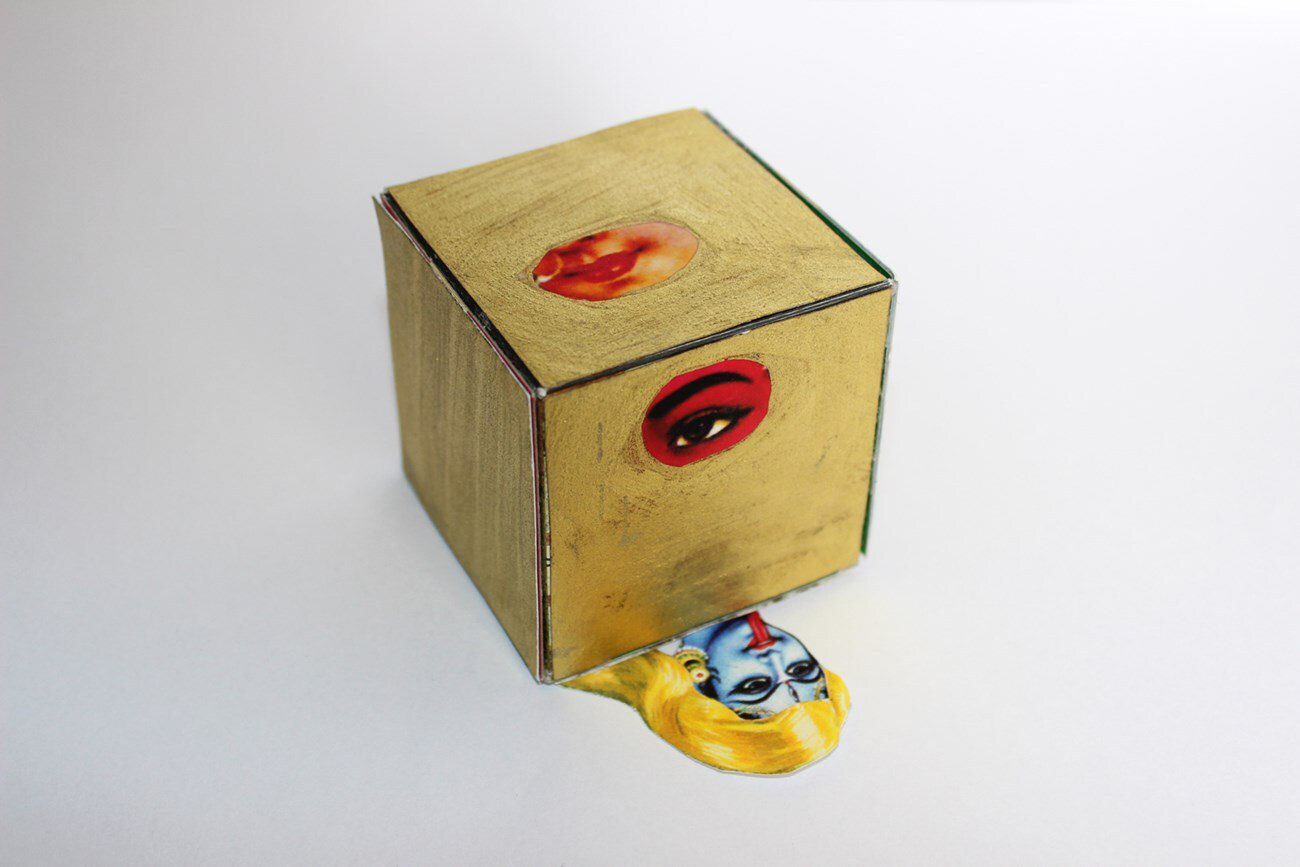
The last year has been extremely difficult for a lot of people working within the arts. I wondered whether you would like to talk about some of the ways the pandemic has affected your work?
As a freelance artist whose practice relies entirely on an income from working with various museums, galleries, shools and other cultural organisations, it’s been a challenging time.
Freelance artists working in the cultural sector have found themselves in a vulnerable position - especially those working with precarious contracts, which provide very little security and protection.
The issues that the pandemic has highlighted with inequality and structural racism have felt very real for me and are things I have observed throughout my life and as an artist working in this sector.
However, the last few months have given me time to reflect on my years of experience working as an artist and facilitator, to think about my relationships with the different institutions, and to consider who sees the value in artists and understands how to work with them.
I’ve also received opportunities to use my years of experience working across organisations and collections, to bring together my different interests within learning, research and my practice.
This includes working with Jean Campbell and Ayisha De Lanerolle to develop arts based experiential training to build capacities to have challenging conversations around race and decolonising with The Pitt Rivers Museum. As well as contributing to a sound installation A Proposal for Radical Hospitality at the Queen’s House Art Gallery composed by Peter Adjaye and curated by Matty Pye.
Collections can provide us with powerful means to centre narratives and the lived experiences of those who have been silenced, erased and ignored.
I hope that the cultural institutions can learn from this period, re-structure and create a space that is more collaborative, transformative, radical and caring.
I’m interested in imagining a future where we ask more direct questions about power and representation and the role of learning in public museums, galleries, libraries, archives and schools. I think artists could play an important part in realising these changes - we know the process of navigating uncertain times.

How has all of this affected your artistic practice?
Within this space of uncertainty, some opportunities have become available for me with my practice. I was awarded an a-n bursary: Time Space Money, which has allowed me the much needed time and support to continue my professional practice. This covered a short, specific period of time where I was able to re-connect and centre my practice in a way that I’ve wanted to do for a long time.
It has made me realise the need to look for more funded opportunities in order to develop my work and to have more time to reflect, research, learn and realise new ideas. I’m also keen to learn stop-frame animation to give me more scope to manipulate and play with the movement of images. I have also returned to my love of textiles with stitch and tapestry.
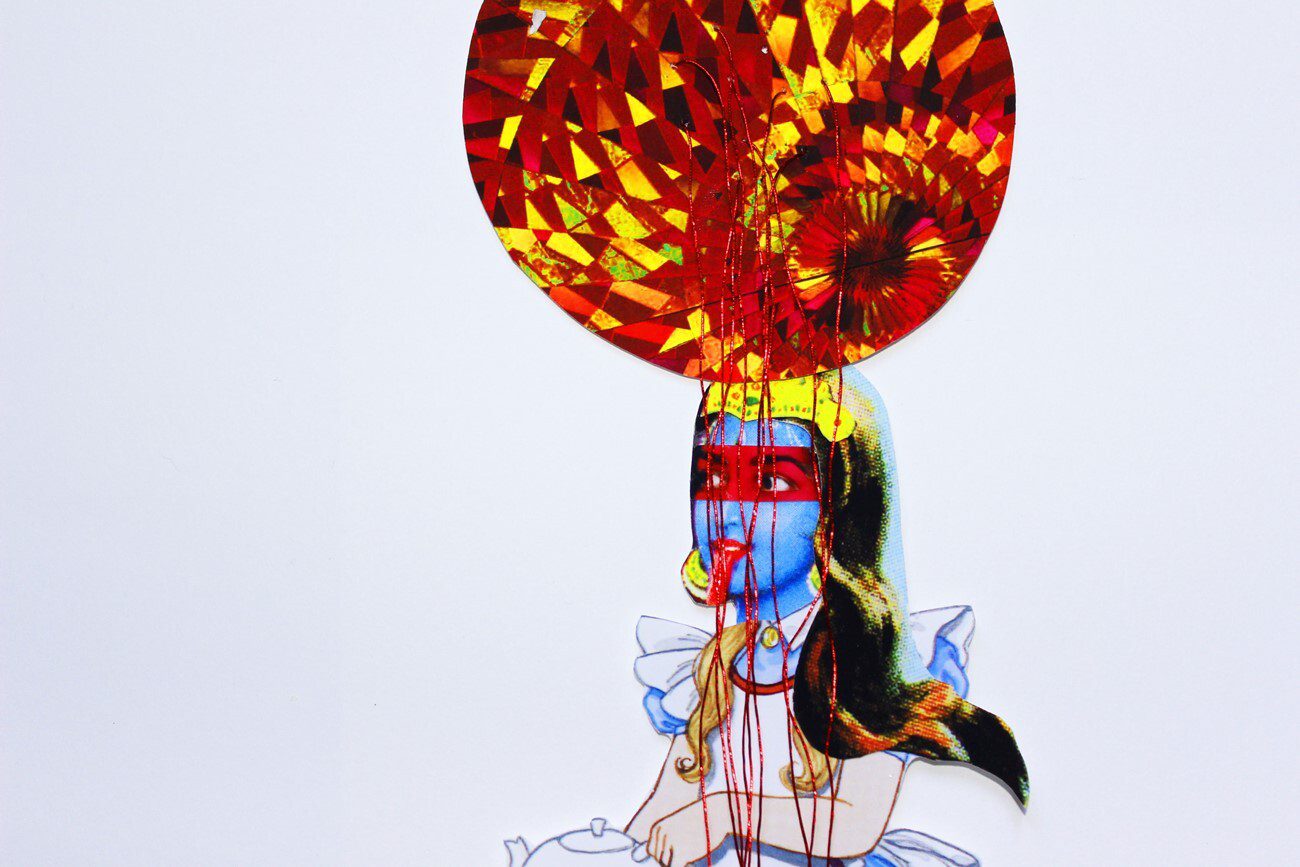
You’ve previously mentioned some of the writers and texts influencing your current work. Who else would you say was a current influence?
At this moment in time my focus seems to be on looking at authors, musicians, historians and activists who are all part of my research. Some I’m returning to, and others are new, all inform the work that I do. To name but a few: Sara Ahmed, Audre Lorde, Angela Davis, David Olusoga, Akala, Darren Chetty, Rebecca Solnit, Maya Angelou, James Baldwin, Reni Eddo-Lodge and Michael Kiwanuka.
More information:
Artists
Tags, Topics, Artforms, Themes and Contexts, Formats
Share this article
Helping Artists Keep Going
Axis is an artist-led charity supporting contemporary visual artists with resources, connection, and visibility.


